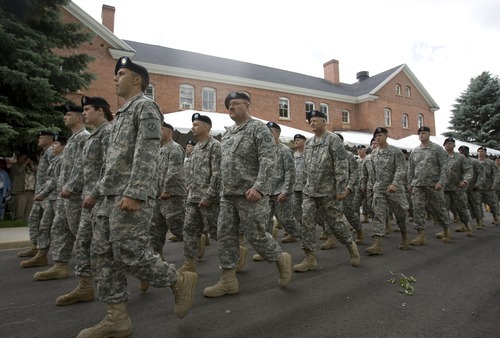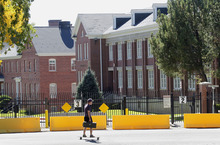This is an archived article that was published on sltrib.com in 2012, and information in the article may be outdated. It is provided only for personal research purposes and may not be reprinted.
One-hundred-fifty years ago this week, a brash U.S. Army officer rode with his soldiers to the foothills overlooking Salt Lake City, planted a flag and called it a military post.
It was a bold move and denounced by Mormon leader Brigham Young, but Fort Douglas would in the ensuing decades play an important role in Utah's evolution from a theocracy to the 45th state in the union.
The 150th anniversary of the historic fort is being commemorated Friday at the Fort Douglas Military Museum.
Director Robert Voyles will discuss the importance of the fort to Utah and the University of Utah, and will name the main gallery building for a major donor, Ezekiel R. Dumke Jr. The 3 p.m. event is by invitation only.
The fort, which was 2,500 acres when Col. Patrick E. Connor planted the flag on Oct. 26, 1862, grew to more than 10,000 acres before the federal government began parceling it out, mostly after World War II.
The fort covered a wide swath, land now occupied by the Veterans Affairs Hospital, Red Butte Garden Arboretum, the University Medical Center and Research Park, and even This Is the Place Monument and Heritage Park.
When the fort formally closed on Oct. 26, 1991, all but 64 acres went to the University of Utah, which agreed to maintain the museum, chapel and historic buildings and to keep the parade grounds as open space.
The U. got another 11 acres for the Olympic Village in 1999.
The U.S. Army continues to hold title to just 53 acres at what is called Stephen A. Douglas Armed Forces Reserve Center, where several hundred Army, Marine and Navy reservists and civilians work today in both historic and 20th century structures.
—
An 'Oh my gosh' moment for Mormons • From the very start, the fort had more than a military mission, although it played an important role in protecting the Overland Stage to and from California and the new Pacific Telegraph.
The fact that Connor named the new camp for an arch-opponent of polygamy, the late senator Douglas, signaled the other reason for the fort: to keep Brigham Young in check.
The president of The Church of Jesus Christ of Latter-day Saints, who had led his people to Utah 15 years earlier, was openly contemptuous of the U.S. government and operated a "State of Deseret" even as Utah was ostensibly a U.S. Territory.
The United States had diverted all its soldiers to the Civil War the year before, and Connor and his Second California volunteers were to reestablish a federal presence.
"It catches them all (settlers) by surprise," says museum director Bob Voyles. "He just kind of squats down and plants the flag," in a place where he can watch the Mormon doings and has a ready water supply from Red Butte Creek.
"It was one of those, 'Oh my gosh' awakenings for the Mormons."
Historian Will Bagley says recent scholarship shows Young was not as neutral during the Civil War as earlier supposed.
Bagley details this in his piece, "A Terror to Evil-Doers: Camp Douglas, Abraham Lincoln, and Utah's Civil War," which appears in the fall 2012 edition of Utah Historical Quarterly.
Young was sympathetic to the Confederates, refused to send troops to help the Union, and was highly derisive of President Lincoln.
Young and Connor were natural enemies, and acted like it for years, even after Connor left the Army and stayed in Utah, becoming the father of the mining industry.
"Up until Brigham Young's death (in 1877), he and Connor were probably the two most important people in the territory, yet you don't hear much about Connor," says Voyles.
Every gentile and anti-Mormon cause found support at Fort Douglas or with Connor, Voyles says.
Utah's first daily newspaper, "The Union Vedette," was founded at the fort and provided a voice for disenchanted Mormons as well as gentiles.
"There was a growing tide of dissent, and Fort Douglas was really there to protect Utahns' rights as American citizens, Bagley says.
"It gave people hope and provided alternate markets," as the fort became a prime buyer for agricultural products and other supplies.
—
A mentor for miners • Once the Civil War ended, Connor went back to Washington and argued, successfully, to keep Fort Douglas open, in part because Mormons practiced polygamy, which, with slavery, was seen as one of the "twin relics of barbarism."
The church would officially end the practice in 1890.
The fort generally had 500 or 600 soldiers through much of the late 1800s, and those soldiers backed up U.S. marshals cracking down on polygamists.
Fort Douglas is also important because it imported American culture to Utah, Bagley says. For instance, it had several units of Buffalo soldiers, black soldiers, in the mid-1890s, the first fort near a city to do so.
Utahns were at first angry at the presence of black soldiers, but the soldiers' behavior won them over, as did their valor in Cuba during the Spanish American War.
During World War I, soldiers from throughout the West were inducted at Fort Douglas. An area of the fort where the Huntsman Center now stands held German prisoners of war and Americans whose loyalty was in question.
The fort was probably at its peak, with 4,000 military and civilian employees, in World War II when it was a major center for troops joining the Army.
Bagley believes that Fort Douglas' most lasting impact may be its role in the state's mining industry. Connor urged his soldiers, who had been prospectors and miners in California, to explore for minerals.
"He wanted more gentiles here," says Voyles. "If you strike gold, how fast can you get gentiles?"
Connor, who invested in many ventures and even staked many of the original claims, become the father of Utah mining. The fort he established gave gentile miners protection.
"That's the most profound impact, because mining was the foundation of Utah's economy well into the 20th century," says Bagley.
The future of Fort Douglas
The U. has long hoped to move into the Army's last holding of about 50 acres in historic Fort Douglas — a move Utah Sen. Orrin Hatch is now trying to expedite. See the Tribune's recent story.





